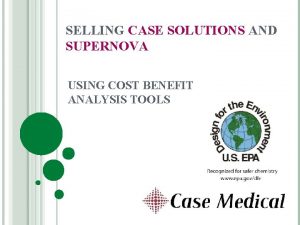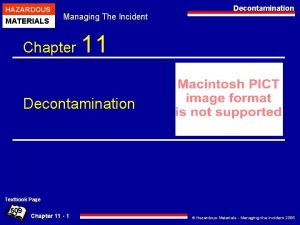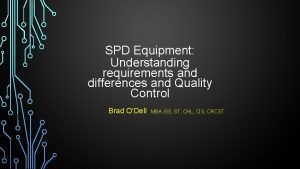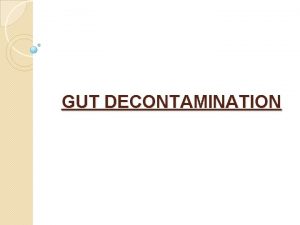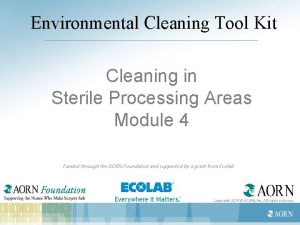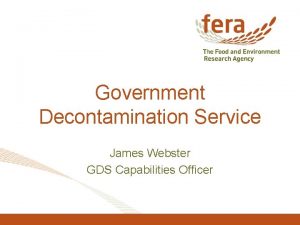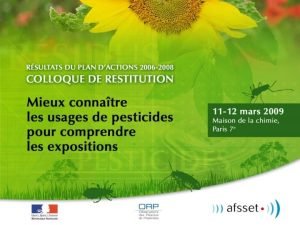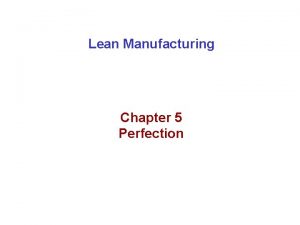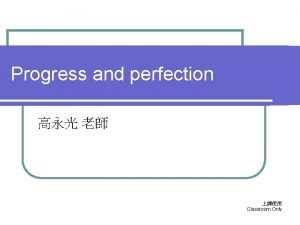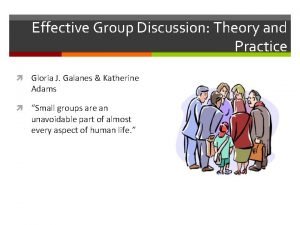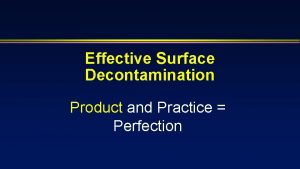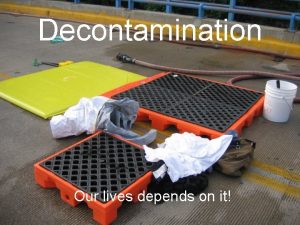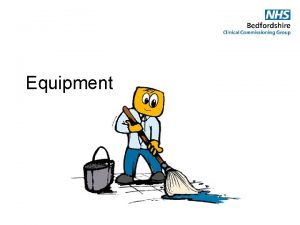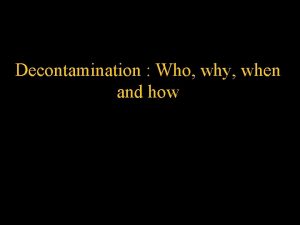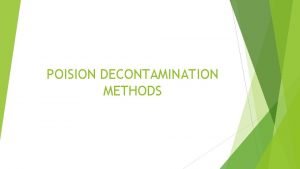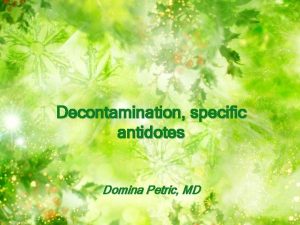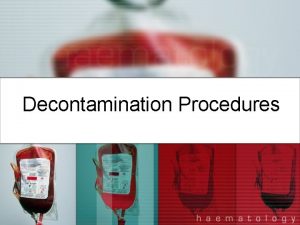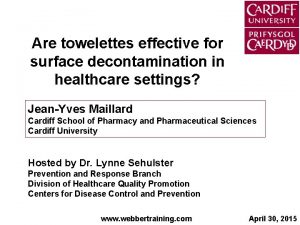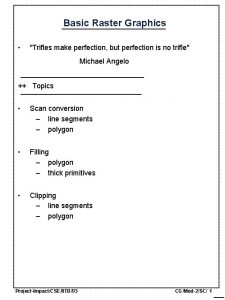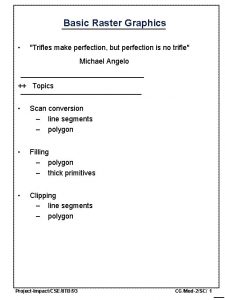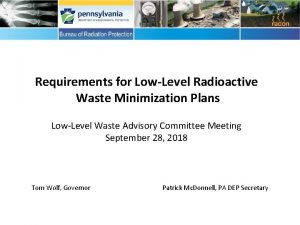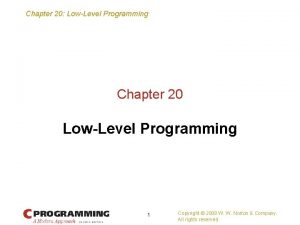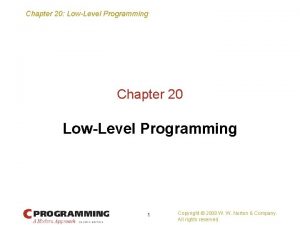Effective Surface Decontamination Product and Practice Perfection LOWLEVEL























- Slides: 23

Effective Surface Decontamination Product and Practice = Perfection

LOW-LEVEL DISINFECTION FOR NONCRITICAL EQUIPMENT AND SURFACES Germicide Exposure time > 1 min Use Concentration Ethyl or isopropyl alcohol 70 -90% Chlorine 100 ppm (1: 500 dilution) Phenolic UD Iodophor UD Quaternary ammonium UD Improved hydrogen peroxide 0. 5%, 1. 4% __________________________ UD=Manufacturer’s recommended use dilution


Does Improving Surface Cleaning and Disinfection Reduce Healthcare-Associated Infections? Donskey CJ. AJIC 2013; 41: S 12 -S 19 “As reviewed here, during the past decade a growing body of evidence has accumulated suggesting that improvements in environmental disinfection may prevent transmission of pathogens and reduce HAIs. Although, the quality of much of the evidence remains suboptimal, a number of high-quality investigations now support environmental disinfection as a control strategy”

Alfa et al. AJIC 2015; 43: 141 -146

Use of a Daily Disinfectant Cleaner Instead of a Daily Cleaner Reduced HAI Rates Alfa et al. AJIC 2015. 43: 141 -146 • • • Method: Improved hydrogen peroxide disposable wipe was used once per day for all high-touch surfaces to replace cleaner Result: When cleaning compliance was ≥ 80%, there was a significant reduction in cases/10, 000 patient days for MRSA, VRE and C. difficile Conclusion: Daily use of disinfectant applied to environmental surfaces with a 80% compliance was superior to a cleaner because it resulted in

It appears that not only is disinfectant use important but how often is important Daily disinfection vs clean when soiled

Daily Disinfection of High-Touch Surfaces Kundrapu et al. ICHE 2012; 33: 1039 Daily disinfection of high-touch surfaces (vs cleaned when soiled) with sporicidal disinfectant (PA) in rooms of patients with CDI and MRSA reduced acquisition of pathogens on hands after contact with surfaces and of hands caring for the patient

Effective Surface Decontamination Product and Practice = Perfection

Wipes Cotton, Disposable, Microfiber, Cellulose-Based, Nonwoven Spunlace Wipe should have sufficient wetness to achieve the disinfectant contact time (e. g. >1 minute)

Thoroughness of Environmental Cleaning Carling P. AJIC 2013; 41: S 20 -S 25 >110, 000 Objects Mean = 32%

Mean proportion of surfaces disinfected at terminal cleaning is 32% Terminal cleaning methods ineffective (products effective practices deficient [surfaces not wiped]) in eliminating epidemiologically important pathogens

MONITORING THE EFFECTIVENESS OF CLEANING Cooper et al. AJIC 2007; 35: 338; Carling P AJIC 2013; 41: S 20 -S 25 • • Visual assessment-not a reliable indicator of surface cleanliness ATP bioluminescence-measures organic debris (each unit has own reading scale, <250 -500 RLU) Microbiological methods-<2. 5 CFUs/cm 2 -pass; can be costly and pathogen specific Fluorescent marker-transparent, easily cleaned, environmentally stable marking solution that fluoresces when exposed to an ultraviolet light (applied by IP unbeknown to EVS, after EVS

Percentage of Surfaces Clean by Different Measurement Methods Rutala, Gergen, Sickbert-Bennett, Huslage, Weber. 2013 Fluorescent marker is a useful tool in determining how thoroughly a surface is wiped and mimics the microbiological data better than ATP

ALL “TOUCHABLE” (HAND CONTACT) SURFACES SHOULD BE WIPED WITH DISINFECTANT “High touch” objects only recently defined (no significant differences in microbial contamination of different surfaces) and “high risk” objects not epidemiologically defined.

NEW “NO TOUCH” APPROACHES TO ROOM DECONTAMINATION Supplement Surface Disinfection Rutala, Weber. Infect Control Hosp Epidemiol. 2013; 41: S 36 -S 41

EFFECTIVENESS OF UV-C FOR ROOM DECONTAMINATION (Inoculated Surfaces) Pathogens Dose* MRSA, VRE, MDR-A Mean log 10 Reduction Shadow Time Reference 12, 000 3. 90 -4. 31 3. 25 -3. 85 ~15 min Rutala W, et al. 1 C. difficile 36, 000 4. 04 2. 43 ~50 min Rutala W, et al. 1 MRSA, VRE 12, 000 >2 -3 NA ~20 min Nerandzic M, et al. 2 C. difficile 22, 000 >2 -3 NA ~45 min Nerandzic M, et al. 2 C. difficle 22, 000 2. 3 overall 67. 8 min Boyce J, et al. 3 MRSA, VRE, MDR-A, Asp 12, 000 3. -5 ->4. 0 1. 7 ->4. 0 30 -40 min Mahida N, et al. 4 MRSA, VRE, MDR-A, Asp 22, 000 >4. 0* 1. 0 -3. 5 60 -90 min Mahida N, et al. 4 1 ICHE 2 BMC 2010; 31: 1025; C. difficile, G. stear Mean log 10 Reduction Line of Sight 5 ICHE N 2010; 10: 197; 3 ICHE 2011; 32: 737; 2012; 33: 507 -12 22, 000 overall 4 JHI 2013; 84: 323 l 73 min Havill et al 5 6 ICHE 2013; 34: 466 spore 2. 2 * Ws/cm 2; min = minutes; NA = not available

HP for Decontamination of the Hospital Environment Falagas et al. J Hosp Infect. 2011; 78: 171 Author, Year HP System Pathogen Before HPV After HPV French, 2004 VHP MRSA 61/85 -72% 1/85 -1% 98 Bates, 2005 VHP Serratia 2/42 -5% 0/24 -0% 100 Jeanes, 2005 VHP MRSA 10/28 -36% 0/50 -0% 100 Hardy, 2007 VHP MRSA 7/29 -24% 0/29 -0% 100 Dryden, 2007 VHP MRSA 8/29 -28% 1/29 -3% 88 Otter, 2007 VHP MRSA 18/30 -60% 1/30 -3% 95 Boyce, 2008 VHP C. difficile 11/43 -26% 0/37 -0% 100 Bartels, 2008 MRSA 4/14 -29% 0/14 -0% 100 HP dry mist % Reduction

Clinical Trials Using HP for Terminal Room Disinfection to Reduce HAIs Weber, Rutala et al. Am J Infect Control, In press Author, Year Design Pathogen Reduction in HAIs Boyce, 2008 Before-After CDI Yes Cooper, 2011 Before-After CDI Decrease cases (incidence not stated) Passaretti, 2013 Prospective cohort MRSA, VRE, CDI Yes, in all MDROs Manian, 2013 Before-After CDI Yes Mitchell, 2014 Before-After MRSA Yes

Clinical Trials Using UV for Terminal Room Disinfection to Reduce HAIs Weber, Rutala et al. Am J Infect Control, In press Author, Year Design Pathogens Reduction in HAIs Levin, 2013 Before-After, Pulsed Xenon CDI Yes Hass, 2014 Before-After, Pulsed Xenon CDI, MRSA, VRE, MDRO-GNR Yes Miller, 2015 Before-After, Pulsed Xenon CDI Yes Nagaraja, 2015 Before-After, Pulsed Xenon CDI Yes (p=0. 06) Pegues, 2015 Before-After, Optimum CDI Yes MRSA, VRE, CDI Yes Anderson, 2015 Randomizedcontrolled trial, Tru-D

This technology should be used (capital equipment budget) for terminal room disinfection (e. g. , after discharge of patients under CP, during outbreaks).

Selection of a UV or HP Device Weber, Rutala et al. Am J Infect Control, In press • • Since different UV and hydrogen peroxide systems vary substantially, infection preventionists should review the peer-reviewed literature and choose only devices with demonstrated bactericidal capability as assessed by carrier tests and/or the ability to disinfect actual patient rooms Ultimately, one would select a device that has demonstrated bactericidal capability and the

Must improve thoroughness of cleaning/disinfection daily basis also, evaluate new technologies
 Supernova
Supernova Contamination vs cross contamination
Contamination vs cross contamination Steelco endoscope decontamination equipment
Steelco endoscope decontamination equipment Gut decontamination
Gut decontamination Sterile processing decontamination ppe
Sterile processing decontamination ppe Government decontamination service
Government decontamination service Sphair decontamination
Sphair decontamination Perfec half
Perfec half Peer editing meaning
Peer editing meaning Fallacy of helplessness
Fallacy of helplessness Excellence vs perfection
Excellence vs perfection Perfection of securities
Perfection of securities Pursue perfection lean
Pursue perfection lean Organs of extreme perfection
Organs of extreme perfection There is no greater bore than perfection example
There is no greater bore than perfection example Perception of perfection
Perception of perfection Perfection
Perfection Admirable goal
Admirable goal Purrsuit of perfection
Purrsuit of perfection Classroom perfection
Classroom perfection Effective teaching evidence and practice
Effective teaching evidence and practice Effective group discussion defines human communication as
Effective group discussion defines human communication as Wet curved surface area
Wet curved surface area Finding lateral area
Finding lateral area
